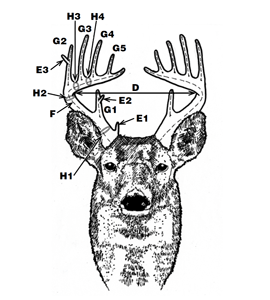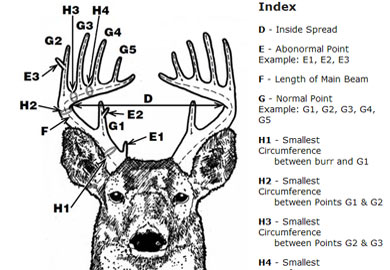How Score Deer Antlers: Expert Tips for Accurate Measuring
Scoring deer antlers can be both exciting and educational. It helps hunters and wildlife enthusiasts understand the size and structure of deer.
Deer antlers have always fascinated people with their unique shapes and sizes. Scoring them provides a way to measure and compare these natural trophies. Whether you’re a seasoned hunter or a curious beginner, learning how to score deer antlers can add a new dimension to your outdoor adventures.
This method involves examining various aspects of the antlers, such as length, spread, and points. By understanding these elements, you can accurately score and appreciate the antlers. Let’s dive into the process and discover how to score deer antlers like a pro.
Introduction To Deer Antler Scoring
Deer antler scoring is a fascinating process. Hunters and wildlife enthusiasts use it to measure and compare antlers. It helps in recognizing the quality of a deer. Scoring antlers is not just about size. It also involves symmetry and other characteristics. This introduction will explore the purpose and history of deer antler scoring.
Purpose Of Scoring
The main purpose of scoring deer antlers is to assess the quality of the deer. Hunters use scores to compare their trophies. Wildlife biologists use scores to study deer populations. Scoring helps in managing and conserving deer species.
Why Score Deer Antlers?
- Comparing: Hunters compare their antlers with others.
- Research: Biologists study deer health and genetics.
- Conservation: Helps in managing deer populations.
History Of Antler Scoring
The history of antler scoring dates back many years. Early hunters used simple methods to measure antlers. Over time, more accurate systems were developed. The Boone and Crockett Club, founded in 1887, created one of the first scoring systems.
- 1800s: Simple measurements by early hunters.
- 1887: Boone and Crockett Club established.
- 1950s: Pope and Young Club created a new scoring system.
- Today: Modern methods combine technology and tradition.
Deer antler scoring has evolved over the years. Today, it is a precise science. It plays a crucial role in hunting and wildlife management.
Essential Tools For Measuring
To accurately score deer antlers, you need the right tools. Measuring antlers requires precision. Each tool serves a specific purpose. Below, we will discuss the essential tools for measuring.
Measuring Tape
A measuring tape is crucial. It helps measure the length of the antlers. Use a flexible tape. This allows you to measure curved surfaces easily. Ensure the tape has clear, easy-to-read markings.
Calipers And Rulers
Calipers are perfect for measuring antler width. They provide precise measurements. Use them for inside and outside spreads. Digital calipers can give exact readings. Rulers help measure tine lengths. They should be straight and sturdy. This ensures accurate readings.
Key Measurements To Take
Scoring deer antlers requires taking precise measurements. Understanding the key measurements ensures accuracy. These measurements provide a clear picture of the antler’s size. Let’s explore the main measurements to take.
Length Of Main Beam
The main beam is a primary part of antlers. Measure the length of each beam. Start at the base, where it joins the skull. Follow the curve to the tip. Use a flexible tape measure for accuracy. Record the length of both beams.
Circumference Measurements
Circumference measurements are crucial. Measure at four specific points. First, measure at the smallest place between the burr and the first point. Second, measure between the first and second points. Third, measure between the second and third points. Lastly, measure between the third point and the tip. Record each measurement carefully.

Credit: www.dnr.sc.gov
Understanding Different Scoring Systems
Understanding different scoring systems is essential for anyone interested in deer antlers. Various organizations use unique methods to measure and score antlers. These systems help hunters and enthusiasts compare their trophies on a standardized scale.
Boone And Crockett
The Boone and Crockett Club has one of the most recognized scoring systems. They focus on measuring the antlers of mature, wild, free-ranging animals. Points are given for length, spread, and mass. Each measurement is taken with precision to ensure accuracy. Typical and non-typical antlers have different categories.
Pope And Young
The Pope and Young Club specializes in archery-harvested animals. Their scoring system is similar to Boone and Crockett but exclusively for bowhunters. They also measure length, spread, and mass. This system highlights the skill involved in bowhunting. Both typical and non-typical antlers are recognized.
Step-by-step Scoring Process
Understanding how to score deer antlers can be rewarding. This guide breaks down the process into simple steps. Follow these instructions to get accurate measurements. Scoring deer antlers involves preparation, setup, and recording measurements. Let’s dive into the details.
Preparation And Setup
Before scoring, gather all necessary tools:
- Flexible steel tape
- Measuring tape
- Pen and paper
- Calculator
- Antler scoring chart
Find a well-lit workspace. Ensure you have a clean, flat surface. It’s essential for taking precise measurements. Place the antlers securely on this surface.
Inspect the antlers. Remove any debris or dirt. Clean antlers give more accurate results. Familiarize yourself with the antler’s parts. Understanding these parts helps in taking correct measurements.
Recording Measurements
Start by measuring the main beam length. Do this for both antlers. Use a flexible steel tape. Record each measurement on your paper.
Next, measure the tine lengths. Tines are the points on the antlers. Measure from the base to the tip of each tine. Record these measurements carefully.
Measure the spread of the antlers. There are three types of spread:
- Tip-to-tip spread
- Greatest spread
- Inside spread
Each type of spread requires specific steps. Follow the antler scoring chart for guidance.
Now, measure the circumferences. Start at the base. Measure at four locations on each antler. Use the measuring tape for this. Record each circumference accurately.
Finally, calculate the total score. Add all measurements together. Use the antler scoring chart to confirm your results. Double-check your entries for accuracy.
Scoring deer antlers is a precise task. With practice, you’ll get better at it. Remember to keep your tools handy and your measurements accurate. Additionally, understanding the nuances of antler scoring can enhance your overall hunting experience. For those interested in maximizing their potential in the field, it might also be helpful to familiarize themselves with ladder deer stand construction details, ensuring a comfortable and efficient setup for observation. With the right knowledge and resources, you’ll be well-prepared for each hunting season.

Credit: lansingsci.com
Common Mistakes To Avoid
Scoring deer antlers can be exciting. Yet, many enthusiasts make mistakes. These errors affect the accuracy of the score. Here are common mistakes to avoid.
Inaccurate Measurements
One common mistake is taking inaccurate measurements. Using the wrong tools can lead to errors. A flexible tape measure is ideal. Ensure it is in good condition. A rigid ruler won’t capture the curves well.
Also, measure from the correct points. Start from the base. Follow the curve of the antler. If you miss a curve, the score will be wrong. Measure each tine separately. This ensures all points are counted.
| Measurement Tips | Explanation |
|---|---|
| Use Flexible Tape | Captures the natural curve of antlers. |
| Start at the Base | Ensures you measure the entire antler. |
| Measure Each Tine | Includes all points in the score. |
Overlooking Abnormal Points
Overlooking abnormal points is another mistake. Not all points are typical. Some may be non-typical. These affect the score differently. Identify and measure these points.
To do this, use the Boone and Crockett scoring system. This system distinguishes typical from non-typical points. It also helps in counting only the valid points.
- Identify Abnormal Points: Non-typical points affect the score.
- Use the Correct System: Boone and Crockett system is reliable.
- Count Valid Points Only: Helps in accurate scoring.
In summary, avoid these common mistakes. Ensure accurate measurements. Identify abnormal points. This will give you a true score of the deer antlers.
Tips From Experts
Scoring deer antlers can be an art. Experts have shared valuable tips to help you. These tips can make the process easier and more accurate. Follow these best practices and advanced techniques.
Best Practices
First, measure the main beam length. Use a flexible tape measure. Start at the antler base. Follow the curve to the tip. Record the length to the nearest eighth of an inch.
Next, measure the tine lengths. Measure each tine from the main beam. Record each length. Ensure accuracy for each measurement.
Measure the inside spread of the main beams. This is the widest point between the beams. Record this measurement. It is crucial for the final score.
Measure the circumference between the tines. Measure at four locations. Record these measurements. They add to the overall score.
Advanced Techniques
Experts recommend double-checking all measurements. Use a second tape measure. Compare results for consistency. It ensures accuracy.
Consider measuring in a controlled environment. Avoid distractions. Ensure proper lighting. It helps see all details.
Use a scoring sheet. Record all measurements systematically. It helps track progress. It ensures no steps are missed.
Compare your scores with official records. It provides a benchmark. It helps identify any discrepancies. It can validate your scoring.
Practice regularly. It improves your skills. It makes the process quicker. It ensures more accurate scores.
Interpreting Your Score
After measuring deer antlers, interpreting the score is crucial. Understanding what the score means helps in comparing different antlers and knowing their rank. Here’s how to interpret your score effectively.
Comparing Scores
Comparing deer antler scores helps in understanding their relative size. Here are some tips to compare scores:
- Typical Scores: These are for antlers that are symmetrical. They are compared to standard measurements.
- Non-Typical Scores: These include irregular points. They are usually higher due to the extra points.
Use the following table for quick reference:
| Score Type | Characteristics |
|---|---|
| Typical | Symmetrical, standard points |
| Non-Typical | Irregular, extra points |
Understanding Rankings
Knowing the rank of your deer antlers is exciting. Here’s how to understand the ranking system:
- Boone and Crockett: This is a popular scoring system. It ranks antlers based on size and symmetry.
- Pope and Young: This is for bowhunting. It also considers symmetry and size.
- SCI: Safari Club International uses its own scoring system. It is different from Boone and Crockett.
These rankings help in comparing your score with others. Knowing where your antlers stand is rewarding.

Credit: www.dnr.sc.gov
Frequently Asked Questions
What Is The Purpose Of Scoring Deer Antlers?
Scoring deer antlers helps hunters and wildlife enthusiasts measure and compare antler size. It provides a standardized way to evaluate and document their trophies.
How Do You Measure Deer Antlers?
Measure the main beams, tine lengths, and circumferences of the antlers. Add these measurements together following official scoring guidelines.
What Equipment Do I Need To Score Antlers?
You’ll need a measuring tape, a score sheet, and a flexible steel cable. These tools help you accurately measure the antlers.
Can I Score Antlers At Home?
Yes, you can score antlers at home with the right equipment. Follow the guidelines provided by official scoring systems for accuracy.
Conclusion
Scoring deer antlers can be a rewarding experience. With practice, it gets easier. Remember to measure carefully and record your results. This helps track deer development over time. Sharing your scores with friends can be fun. It also contributes to wildlife management.
Keep your tools handy and stay patient. Enjoy the process and respect the wildlife. Happy scoring!







